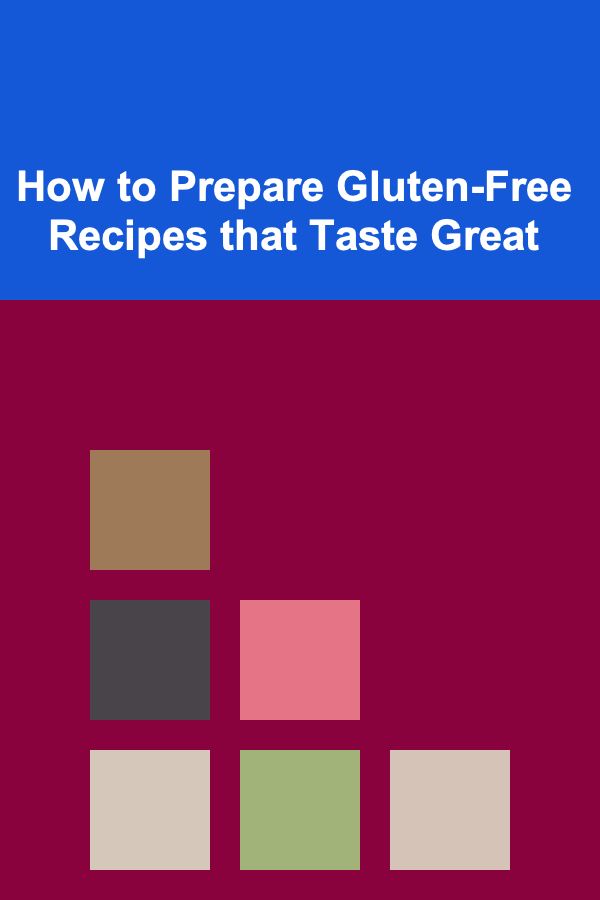
How to Prepare Gluten-Free Recipes that Taste Great
ebook include PDF & Audio bundle (Micro Guide)
$12.99$11.99
Limited Time Offer! Order within the next:

Gluten-free eating has become more popular than ever, with many people opting for gluten-free diets due to health concerns, food allergies, or lifestyle preferences. However, one of the biggest challenges when preparing gluten-free meals is ensuring that the food still tastes great. Gluten, found in wheat, barley, and rye, is responsible for the elasticity and texture in baked goods and many traditional dishes. Removing it from recipes often results in a different texture and flavor profile, which can be frustrating for those new to gluten-free cooking.
In this article, we will dive into the essential principles and techniques for creating gluten-free dishes that not only meet dietary restrictions but also satisfy the taste buds. Whether you are new to gluten-free cooking or have been preparing gluten-free meals for years, this guide will provide valuable tips and tricks to help you prepare delicious, flavorful, and texture-perfect gluten-free recipes.
Understanding Gluten-Free Ingredients
Before diving into specific recipes, it's essential to understand the ingredients that make up a gluten-free diet. Gluten-free recipes use alternative flours, starches, and binders to replace traditional wheat flour. While this may seem daunting at first, these gluten-free alternatives can be just as delicious and versatile when used properly.
1. Gluten-Free Flours
The foundation of many gluten-free recipes is the flour used. There are various gluten-free flours available, each with its unique properties. Here are some common types of gluten-free flours:
- Almond Flour: Made from finely ground almonds, almond flour is a popular choice for gluten-free baking. It imparts a moist, nutty flavor and works well in cakes, cookies, and muffins.
- Rice Flour: Rice flour is often used in gluten-free recipes as it is light and neutral in flavor. It is a staple in many gluten-free flour blends and is particularly good for breading and thickening sauces.
- Coconut Flour: This flour is made from dried coconut meat and is highly absorbent. It works well in small amounts, typically combined with other flours, and adds a subtle coconut flavor to baked goods.
- Sorghum Flour: Sorghum flour is a whole grain flour that is often used in gluten-free baking. It has a mild flavor and is rich in fiber and antioxidants. It works well in bread and other hearty baked goods.
- Tapioca Flour (or Tapioca Starch): Tapioca flour is derived from the root of the cassava plant and is primarily used as a thickening agent. It adds a chewy texture to gluten-free baked goods.
- Cornstarch: Cornstarch is another essential gluten-free ingredient that helps improve the texture of baked goods and can be used to thicken sauces or soups.
2. Gluten-Free Binders and Thickeners
Since gluten provides elasticity and structure to baked goods, gluten-free recipes often require other ingredients to mimic this function. Common gluten-free binders include:
- Xanthan Gum: A fermented sugar that helps bind ingredients and provides structure to gluten-free baked goods. It's often used in small amounts, typically around 1 teaspoon per cup of gluten-free flour.
- Guar Gum: Similar to xanthan gum, guar gum is another binding agent that is often used in gluten-free baking. It can help with texture and moisture retention.
- Psyllium Husk: Psyllium husk is a natural fiber that helps create a chewy texture in gluten-free bread and baked goods. It is especially useful in bread recipes.
- Eggs: Eggs serve as a binder in gluten-free recipes and also help with moisture and structure. For vegan or egg-free options, chia seeds or flaxseeds can act as substitutes.
3. Other Key Gluten-Free Ingredients
- Gluten-Free Oats: Oats are naturally gluten-free but are often contaminated with gluten during processing. Look for certified gluten-free oats to avoid cross-contamination.
- Coconut Oil and Butter: Fats like coconut oil and butter are essential for adding richness and moisture to gluten-free baked goods.
- Dairy and Dairy Alternatives: Many gluten-free recipes use dairy or dairy alternatives such as almond milk, coconut milk, or soy milk. These ingredients can help with moisture and flavor.
Key Techniques for Gluten-Free Cooking and Baking
Making gluten-free recipes that taste great is not just about using the right ingredients. There are also specific techniques and tips that can help achieve the best flavor, texture, and structure.
1. Use a Gluten-Free Flour Blend
One of the challenges of gluten-free baking is achieving a balanced texture and flavor. While single-ingredient flours like rice flour or almond flour have their merits, they may not provide the necessary structure and chewiness that gluten provides in traditional recipes. The solution is often to use a gluten-free flour blend.
A good gluten-free flour blend typically combines various gluten-free flours, starches, and binders to mimic the texture and structure of wheat flour. A common blend includes rice flour, potato starch, and tapioca flour, but you can experiment with different combinations based on the recipe.
2. Add More Moisture
Gluten-free baked goods can sometimes turn out dry or crumbly because the lack of gluten affects moisture retention. To combat this, you may need to increase the amount of moisture in your recipe. Here are a few ways to add moisture to gluten-free recipes:
- Use a Moisture-Rich Fat: Coconut oil, butter, or avocado oil help keep gluten-free baked goods moist and tender.
- Add Moisture-Rich Ingredients: Ingredients like yogurt, sour cream, mashed bananas, or applesauce can add moisture and flavor.
- Consider Adding More Eggs: Eggs contribute both structure and moisture, so using an extra egg or two can help improve the texture.
3. Don't Overmix
One of the things that makes gluten-free baking different from traditional baking is that you don't have to worry about overmixing your batter. Since gluten is not present, there's no risk of developing an unpleasant, tough texture. However, overmixing can still lead to dense, rubbery baked goods, especially when using ingredients like coconut flour.
Mix the batter just until the ingredients are combined to avoid any negative texture issues.
4. Consider Resting the Dough
When baking gluten-free recipes, letting the dough or batter rest can improve the final product. Resting allows the flour blend to absorb the liquids and can help prevent a gritty texture. For cookies, bread, or cakes, letting the dough sit for 20-30 minutes can result in a better texture and more even baking.
5. Invest in the Right Equipment
Certain tools can make gluten-free cooking and baking easier. A good mixer, for instance, can help incorporate air into your batter, resulting in a lighter texture. Additionally, investing in quality baking sheets and pans can ensure even cooking. For bread, consider using a Dutch oven or cast iron pan, as it helps with even heat distribution and creates a crisp crust.
6. Experiment with Alternative Sweeteners
When preparing gluten-free recipes, sugar plays a key role in not only sweetening but also adding moisture. However, some people on a gluten-free diet may also want to avoid refined sugar or are looking for lower glycemic index alternatives. You can experiment with alternative sweeteners like:
- Maple Syrup: Adds a natural sweetness and moisture to baked goods.
- Honey: A natural sweetener that works well in cookies, cakes, and other treats.
- Stevia: A zero-calorie sweetener that can replace sugar in many recipes.
Gluten-Free Recipe Ideas
Now that you have an understanding of the ingredients and techniques involved in gluten-free cooking and baking, let's look at some specific recipes to help you get started.
1. Gluten-Free Pancakes
Ingredients:
- 1 cup gluten-free flour blend
- 1 tablespoon sugar
- 1 teaspoon baking powder
- 1/2 teaspoon salt
- 1 cup almond milk (or other milk)
- 2 large eggs
- 1 tablespoon melted butter or coconut oil
- 1 teaspoon vanilla extract
Instructions:
- In a bowl, whisk together the gluten-free flour, sugar, baking powder, and salt.
- In another bowl, whisk together the almond milk, eggs, melted butter, and vanilla extract.
- Pour the wet ingredients into the dry ingredients and mix until just combined.
- Heat a skillet over medium heat and lightly grease it with butter or oil.
- Pour about 1/4 cup of batter onto the skillet for each pancake.
- Cook until bubbles appear on the surface of the pancake, then flip and cook until golden brown on both sides.
2. Gluten-Free Chocolate Chip Cookies
Ingredients:
- 1 1/2 cups gluten-free flour blend
- 1/2 teaspoon baking soda
- 1/2 teaspoon salt
- 1/2 cup butter, softened
- 1/2 cup coconut sugar
- 1/4 cup maple syrup
- 1 teaspoon vanilla extract
- 1 egg
- 1 cup gluten-free chocolate chips
Instructions:
- Preheat your oven to 350°F (175°C) and line a baking sheet with parchment paper.
- In a bowl, whisk together the gluten-free flour, baking soda, and salt.
- In a separate bowl, cream together the butter, coconut sugar, and maple syrup until smooth and fluffy.
- Add the egg and vanilla extract and mix well.
- Gradually add the dry ingredients to the wet ingredients and mix until combined.
- Stir in the chocolate chips.
- Drop spoonfuls of dough onto the prepared baking sheet and bake for 8-10 minutes, or until the edges are golden brown.
3. Gluten-Free Banana Bread
Ingredients:
- 1 1/2 cups gluten-free flour blend
- 1 teaspoon baking soda
- 1/4 teaspoon salt
- 1/2 cup butter, softened
- 1/2 cup brown sugar
- 2 large ripe bananas, mashed
- 2 large eggs
- 1 teaspoon vanilla extract
- 1/2 cup almond milk
Instructions:
- Preheat the oven to 350°F (175°C) and grease a loaf pan.
- In a bowl, combine the gluten-free flour, baking soda, and salt.
- In another bowl, cream together the butter and brown sugar until light and fluffy.
- Add the mashed bananas, eggs, and vanilla extract and mix well.
- Gradually add the dry ingredients to the wet ingredients, alternating with the almond milk, and mix until combined.
- Pour the batter into the prepared loaf pan and smooth the top.
- Bake for 50-60 minutes, or until a toothpick inserted into the center comes out clean.
Conclusion
Cooking and baking without gluten does not have to mean sacrificing taste or texture. By understanding the right ingredients, techniques, and substitutions, you can create gluten-free recipes that are just as delicious and satisfying as their gluten-filled counterparts. Whether you are preparing a simple dish or experimenting with more complex recipes, keep these tips in mind, and enjoy creating flavorful meals that everyone can enjoy.

How to Choose the Best Security System for Your Budget
Read More
How To Create a Productive Remote Morning Routine
Read More
How to Make a Checklist for Reducing Customer Onboarding Time
Read More
Building a Home on Mars: A Comprehensive Guide to Martian Habitats
Read More
How to Integrate Email Marketing with CRM Systems
Read More
How to Build a Robust Risk Assessment Framework in Supply Chains
Read MoreOther Products

How to Choose the Best Security System for Your Budget
Read More
How To Create a Productive Remote Morning Routine
Read More
How to Make a Checklist for Reducing Customer Onboarding Time
Read More
Building a Home on Mars: A Comprehensive Guide to Martian Habitats
Read More
How to Integrate Email Marketing with CRM Systems
Read More